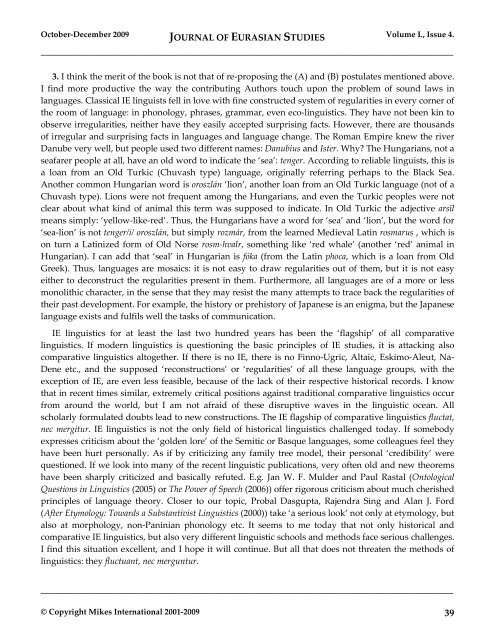JOURNAL OF EURASIAN STUDIES
JOURNAL OF EURASIAN STUDIES
JOURNAL OF EURASIAN STUDIES
You also want an ePaper? Increase the reach of your titles
YUMPU automatically turns print PDFs into web optimized ePapers that Google loves.
October-December 2009 <strong>JOURNAL</strong> <strong>OF</strong> <strong>EURASIAN</strong> <strong>STUDIES</strong> Volume I., Issue 4.<br />
_____________________________________________________________________________________<br />
3. I think the merit of the book is not that of re-proposing the (A) and (B) postulates mentioned above.<br />
I find more productive the way the contributing Authors touch upon the problem of sound laws in<br />
languages. Classical IE linguists fell in love with fine constructed system of regularities in every corner of<br />
the room of language: in phonology, phrases, grammar, even eco-linguistics. They have not been kin to<br />
observe irregularities, neither have they easily accepted surprising facts. However, there are thousands<br />
of irregular and surprising facts in languages and language change. The Roman Empire knew the river<br />
Danube very well, but people used two different names: Danubius and Ister. Why? The Hungarians, not a<br />
seafarer people at all, have an old word to indicate the ‘sea’: tenger. According to reliable linguists, this is<br />
a loan from an Old Turkic (Chuvash type) language, originally referring perhaps to the Black Sea.<br />
Another common Hungarian word is oroszlán ‘lion’, another loan from an Old Turkic language (not of a<br />
Chuvash type). Lions were not frequent among the Hungarians, and even the Turkic peoples were not<br />
clear about what kind of animal this term was supposed to indicate. In Old Turkic the adjective arsïl<br />
means simply: ‘yellow-like-red’. Thus, the Hungarians have a word for ‘sea’ and ‘lion’, but the word for<br />
‘sea-lion’ is not tenger/i/ oroszlán, but simply rozmár, from the learned Medieval Latin rosmarus , which is<br />
on turn a Latinized form of Old Norse rosm-hvalr, something like ‘red whale’ (another ‘red’ animal in<br />
Hungarian). I can add that ‘seal’ in Hungarian is fóka (from the Latin phoca, which is a loan from Old<br />
Greek). Thus, languages are mosaics: it is not easy to draw regularities out of them, but it is not easy<br />
either to deconstruct the regularities present in them. Furthermore, all languages are of a more or less<br />
monolithic character, in the sense that they may resist the many attempts to trace back the regularities of<br />
their past development. For example, the history or prehistory of Japanese is an enigma, but the Japanese<br />
language exists and fulfils well the tasks of communication.<br />
IE linguistics for at least the last two hundred years has been the ‘flagship’ of all comparative<br />
linguistics. If modern linguistics is questioning the basic principles of IE studies, it is attacking also<br />
comparative linguistics altogether. If there is no IE, there is no Finno-Ugric, Altaic, Eskimo-Aleut, Na-<br />
Dene etc., and the supposed ‘reconstructions’ or ‘regularities’ of all these language groups, with the<br />
exception of IE, are even less feasible, because of the lack of their respective historical records. I know<br />
that in recent times similar, extremely critical positions against traditional comparative linguistics occur<br />
from around the world, but I am not afraid of these disruptive waves in the linguistic ocean. All<br />
scholarly formulated doubts lead to new constructions. The IE flagship of comparative linguistics fluctat,<br />
nec mergitur. IE linguistics is not the only field of historical linguistics challenged today. If somebody<br />
expresses criticism about the ‘golden lore’ of the Semitic or Basque languages, some colleagues feel they<br />
have been hurt personally. As if by criticizing any family tree model, their personal ‘credibility’ were<br />
questioned. If we look into many of the recent linguistic publications, very often old and new theorems<br />
have been sharply criticized and basically refuted. E.g. Jan W. F. Mulder and Paul Rastal (Ontological<br />
Questions in Linguistics (2005) or The Power of Speech (2006)) offer rigorous criticism about much cherished<br />
principles of language theory. Closer to our topic, Probal Dasgupta, Rajendra Sing and Alan J. Ford<br />
(After Etymology: Towards a Substantivist Linguistics (2000)) take ‘a serious look’ not only at etymology, but<br />
also at morphology, non-Paninian phonology etc. It seems to me today that not only historical and<br />
comparative IE linguistics, but also very different linguistic schools and methods face serious challenges.<br />
I find this situation excellent, and I hope it will continue. But all that does not threaten the methods of<br />
linguistics: they fluctuant, nec merguntur.<br />
_____________________________________________________________________________________<br />
© Copyright Mikes International 2001-2009 39
















